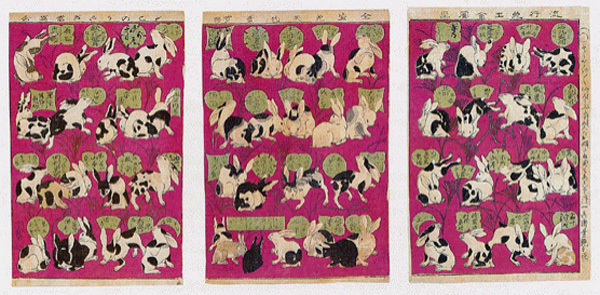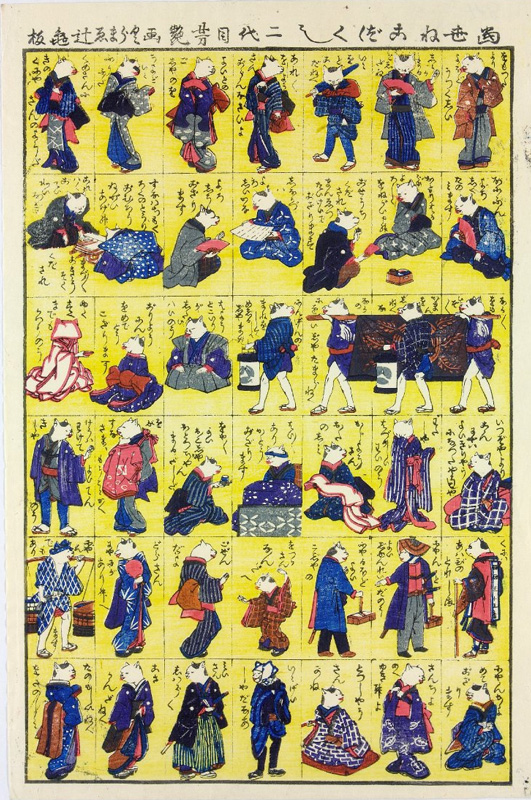Prints in Collection
Biographical Data
Sources: A Dictionary of Japanese Artists: Painting, Sculpture, Ceramics, Prints, Lacquer, Laurance P. Roberts, Weatherhill, 1976, p. 204.
No information is available on the life of Yoshitsuya II 芳艶(二代)other than his real name was Minowa Eikichi 箕輪兵吉1 and he was a student of Utagawa Yoshitsuya (1822-1866). He used the gō Ichiesai 一英斎, Issensha Kison 一仙舎其村 and Yoshitsuya 芳艶. His signatures often look identical to those of his teacher (see gourd shaped cartouche with signature below.)
The artist did a few interesting prints featuring animals such as the two prints shown below. He also created prints depicting legends and historical events, such as this collection's print of a celebration following the government's victory over rebellious samurai in the Satsuma Rebellion.

Ryuko usagi shukkai zue (Rabbit show exhibition list), 1873
National Diet Library call no. 425-14012
Tosei neko zukushi 当世ねこづくし (Collection of Present-day Cats)
British Museum 1872,0713,0.3673
click on image to enlarge
Signatures Attributed to Artist - a few examples
1 Roberts gives his real name as Miwa Yoshitsuya 箕輪芳艶, but his real name as it appears on the publisher's cartouche in this collection's print IHL Cat. #684 is 箕輪兵吉 Minowa Eikichi.
 一英斎芳艶 画 Ichisei Yoshitsuya ga with Yoshi kiri seal: paulownia flower seal |  一英斎芳艶 画 Ichisei Yoshitsuya ga |  Nidaime (2nd generation) Yoshitsuya ga c. 1870 |  一英斎芳艶 画 Ichisei Yoshitsuya ga |
2 The National Diet Library provides us with the story behind this print, as follows:
At the end of the Edo period and the beginning of the Meiji era when Japan resumed diplomatic and trade relations with the countries of the West, many exotic plants and animals were brought into Japan. Among them were rabbit of foreign breeds with strange markings and coloring. From Meiji 5 to Meiji 7 (1872-74), rabbit breeding became very popular in Osaka and Tokyo, and lots of rabbit shows and rabbit markets were held. Above all, the calico (tortoiseshell) rabbit was in demand and sold for ridiculously high prices -- as much as the price of a house. Just as in the "Tulip Bubble" in Holland during the 1630s, people rushed into rabbit breeding as a speculation. Lots of nishiki-e introducing famous rabbit breeders, rabbit breeds, and their owners and addresses, were published. But because the rabbit trade increasingly attracted crime and became a serious social problem, the Tokyo Metropolitan Government brought in regulations requiring traders to notify the authorities of their rabbit dealings and every month to pay one yen tax per rabbit. Thus burst the"Rabbit Bubble."
3 The British Museum provides the following description of this print: "Stages of a courtship and marriage, via an allegory with cats. Text includes puns on Japanese word for 'cat' (neko) and onomatopoiea for 'meow' (nyan).
First horizontal row: A wealthy young male cat (top right) and beautiful female cat (top left) see each other for the first time.
Second row: Parents meet to arrange a dowry and sign the contract.
Third row: The wedding (bride in white at far left).
Fourth row: Stages of pregnancy and giving birth (second from right, the wife embarrassed at her glowing looks; fourth from right in late stage of pregnancy; sixth from right carrying newborn kitten).
Fifth row: Young kitten (center) excited about a visit from a fish monger (far left).
Sixth row: [Topic uncertain]
First horizontal row: A wealthy young male cat (top right) and beautiful female cat (top left) see each other for the first time.
Second row: Parents meet to arrange a dowry and sign the contract.
Third row: The wedding (bride in white at far left).
Fourth row: Stages of pregnancy and giving birth (second from right, the wife embarrassed at her glowing looks; fourth from right in late stage of pregnancy; sixth from right carrying newborn kitten).
Fifth row: Young kitten (center) excited about a visit from a fish monger (far left).
Sixth row: [Topic uncertain]
last revision:
1/7/2019

